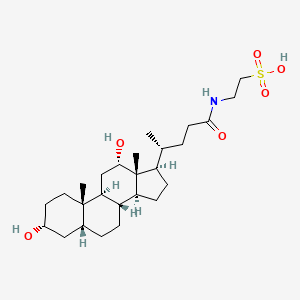| MeSH term | MeSH ID | Detail |
|---|---|---|
| Colitis, Ulcerative | D003093 | 24 associated lipids |
| Adenocarcinoma | D000230 | 166 associated lipids |
| Colonic Neoplasms | D003110 | 161 associated lipids |
| Body Weight | D001835 | 333 associated lipids |
| Cholestasis | D002779 | 23 associated lipids |
| Birth Weight | D001724 | 23 associated lipids |
| Shock, Hemorrhagic | D012771 | 4 associated lipids |
| Gastrointestinal Hemorrhage | D006471 | 27 associated lipids |
| Tay-Sachs Disease | D013661 | 2 associated lipids |
| Fetal Resorption | D005327 | 15 associated lipids |
| Pancreatitis, Acute Necrotizing | D019283 | 18 associated lipids |
| Short Bowel Syndrome | D012778 | 3 associated lipids |
| Gastroesophageal Reflux | D005764 | 10 associated lipids |
Taurodeoxycholic acid
Taurodeoxycholic acid is a lipid of Sterol Lipids (ST) class. Taurodeoxycholic acid is associated with abnormalities such as Ischemia and Wiskott-Aldrich Syndrome. The involved functions are known as Cell Proliferation, Transcriptional Activation, Phosphorylation, Anabolism and Biochemical Pathway. Taurodeoxycholic acid often locates in Body tissue, Epithelium, Blood, Mucous Membrane and Hepatic. The associated genes with Taurodeoxycholic acid are NOX5 gene, GPBAR1 gene, NR1H4 gene and SLC33A1 gene. The related lipids are cholanic acid, taurolithocholic acid 3-sulfate, Sterols, 7-dehydrocholesterol and tauromuricholic acid.
Cross Reference
Introduction
To understand associated biological information of Taurodeoxycholic acid, we collected biological information of abnormalities, associated pathways, cellular/molecular locations, biological functions, related genes/proteins, lipids and common seen animal/experimental models with organized paragraphs from literatures.
What diseases are associated with Taurodeoxycholic acid?
Taurodeoxycholic acid is suspected in Ischemia and other diseases in descending order of the highest number of associated sentences.
Related references are mostly published in these journals:
| Disease | Cross reference | Weighted score | Related literature |
|---|
Possible diseases from mapped MeSH terms on references
We collected disease MeSH terms mapped to the references associated with Taurodeoxycholic acid
PubChem Associated disorders and diseases
What pathways are associated with Taurodeoxycholic acid
There are no associated biomedical information in the current reference collection.
PubChem Biomolecular Interactions and Pathways
Link to PubChem Biomolecular Interactions and PathwaysWhat cellular locations are associated with Taurodeoxycholic acid?
Visualization in cellular structure
Associated locations are in red color. Not associated locations are in black.
Related references are published most in these journals:
| Location | Cross reference | Weighted score | Related literatures |
|---|
What functions are associated with Taurodeoxycholic acid?
Related references are published most in these journals:
| Function | Cross reference | Weighted score | Related literatures |
|---|
What lipids are associated with Taurodeoxycholic acid?
Related references are published most in these journals:
| Lipid concept | Cross reference | Weighted score | Related literatures |
|---|
What genes are associated with Taurodeoxycholic acid?
Related references are published most in these journals:
| Gene | Cross reference | Weighted score | Related literatures |
|---|
What common seen animal models are associated with Taurodeoxycholic acid?
There are no associated biomedical information in the current reference collection.
NCBI Entrez Crosslinks
All references with Taurodeoxycholic acid
Download all related citations| Authors | Title | Published | Journal | PubMed Link |
|---|---|---|---|---|
| Shi C et al. | Potential effects of PKC or protease inhibitors on acute pancreatitis-induced tissue injury in rats. | 2007 | Vascul. Pharmacol. | pmid:17347056 |
| Hismiogullari AA et al. | Isolation and biochemical analysis of vesicles from taurohyodeoxycholic acid-infused isolated perfused rat livers. | 2013 | World J. Gastroenterol. | pmid:24115821 |
| Lopez-Font I et al. | Pancreatic and pulmonary mast cells activation during experimental acute pancreatitis. | 2010 | World J. Gastroenterol. | pmid:20632444 |
| Tascilar O et al. | Protective effects of erythropoietin against acute lung injury in a rat model of acute necrotizing pancreatitis. | 2007 | World J. Gastroenterol. | pmid:18069756 |
| Zhang R et al. | Bile salts inhibit growth and induce apoptosis of culture human normal esophageal mucosal epithelial cells. | 2005 | World J. Gastroenterol. | pmid:16425417 |
| Zhang R et al. | Bile salts inhibit growth and induce apoptosis of human esophageal cancer cell line. | 2005 | World J. Gastroenterol. | pmid:16127738 |
| Scheibner J et al. | Indirect evidence that intestinal bile salt absorption in rats and hamsters is under positive feedback control. | 2001 | Z Gastroenterol | pmid:11778152 |
| Yu J et al. | [Epicatechin abolished TDCA-induced apoptosis in Huh7 cell by inhibiting Bax, p38 MAPK and ROS production]. | 2009 | Zhongguo Zhong Yao Za Zhi | pmid:19673394 |
| Zhang R et al. | [Bile salts induce differentiation in cultured human normal esophageal mucosal epithelial cells]. | 2006 | Zhonghua Yi Xue Za Zhi | pmid:17156647 |
